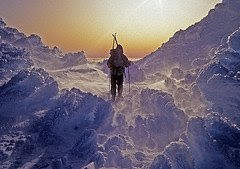June to August is a good time to avoid New Zealand travel– unless you ski or snowboard. I leave my home near a ski resort in the Cascade Mountains and visit New Zealand in their summer season because I don’t want to shovel snow, fall on my butt in the ice, or crawl under my car to pry off a chain that’s wrapped around the axle. But, if you’d like to take a holiday now and get your nose burned on a snow field instead of the beach, the price is right in New Zealand.
New Zealand ski season is June to November. August is the peak season. New Zealand is a volcanic area constantly moving and belching and Kiwis take their skiing seriously. When Mt Ruapaeha in the North Island burped out hot lava, skiers weren’t surprised, only determined they weren’t going to lose a ski season. Kiwis let the mountain go about its business throwing fiery boulders into the air. Then, they slipped down one side of the mountain on skis while lava slipped down the other. There are three main ski areas in the North Island and many in the colder South Island. If you’re a beginner or professional, you can find a New Zealand ski area and price that suits your experience level and your credit card balance. While all New Zealand ski areas cater to snowboarding, Wanaka in the South Island is the snowboarding capital. Ohau Lodge another snowboarding area in the Southern Alps is famous for its parties.
If you still believe the world is flat, try some heli-skiing in the Southern Alps. You better know a little more than how to carry a pair of skis and party with the crowd. Heli-ski companies will transport you up the mountain and you figure out how to get yourself down.
Apollo Motorhomes is offering special rates on their RVs and campervans through August 31, if you book by June 30. Most of the vans I’ve seen around Queenstown have ski racks– you might ask before you rent if you don’t want to sleep with wet skis. Apollo says it has no diesel recovery fee– New Zealand RVs have odometers on their hubs and private owners pay a small fee to the government based on odometer mileage. This is usually included in the rental cost, but with the cost of diesel going up, check first if you’re shopping around. Apollo also advertises unlimited kilometers and GST included. Kilometers on rental vehicles are usually unlimited although some roads are off limits, including one near Wanaca– which you probably couldn’t pass over even if you wanted to in their winter season. GST is very high, so if you’re comparing rental RV rates, ask if the GST is included. Apollo recently bought into the US RV rental market and has a Los Angeles branch. If you’re near California, you might contact them for more information.
If you’d like to spend your summer vacation slipping down a frozen mountain or sitting around a fire in a remote alpine lodge, consider a New Zealand vacation in snow country. If you can’t make it this year, at least dream a little. Turn on your air conditioning and watch a New Zealand ski video.

Lyn Harris
RV in NZ: How to Spend Your Winters South in New Zealand

+copy.jpg)






